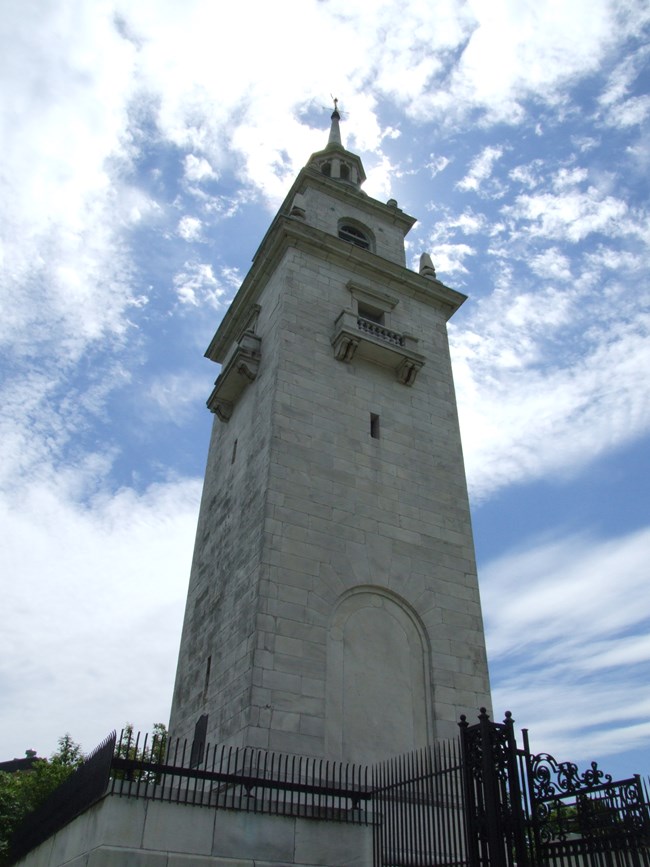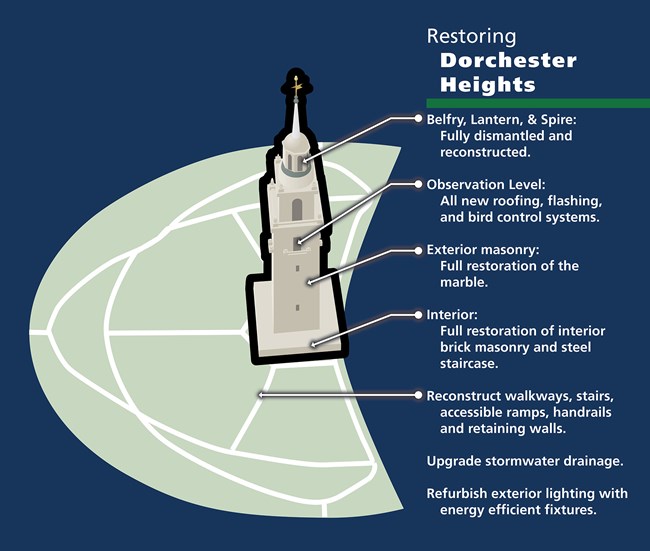Last updated: January 28, 2025
Article
Dorchester Heights Monument Restoration Project Preview

Cultural Landscape Inventory, Boston National Historical Park and Olmstead Center for Landscape, 2010.
In the middle of the night on March 4, 1776, Continental forces surprised British troops by fortifying Dorchester Heights. This action ultimately led to the evacuation of British troops from Boston on March 17, effectively ending the 11-month long Siege of Boston. Since the actions of Continental forces here in March 1776, Dorchester Heights has remained a landmark in our nation's revolutionary landscape.
To recognize the feat achieved over a hundred years prior, Bostonians gathered to dedicate a monument in 1902. This monument continues to stand as a testament to the people who fought for the ideals this country was founded upon.
Yet, this site of national significance has also made its mark on the local community, serving as a gathering space for friends and families for generations. Today, National Parks of Boston continues to steward Dorchester Heights Monument and looks forward to the next chapter of the Monument’s role in its local community and in helping us reflect on our nation’s founding. This next chapter includes a multimillion-dollar restoration project with funding from the Great American Outdoors Act (GAOA). With the completion of this project, the iconic commemorative tower and grounds will be safe and accessible for visitors and continue to serve as a landmark within the community.
Historical Background
Dorchester Heights has a history that spans thousands of years. It has transformed over time from glacier to drumlin, pasture to fort, and then a community park, which still stands today. Learn more about the storied past of Dorchester Heights by clicking the link below.

Learn about the significance of Dorchester Heights through this historical overview. Photo: National Park Service/©Louis S. Glanzman
Current State of the Site
With the creation of Thomas Park in the 1850s and the construction of the tower in the early 1900s, Dorchester Heights Monument has endured all types of weather and experienced shifting grounds. Due to these environmental effects, Dorchester Heights has required updates and restoration throughout the years.

NPS Photo/Gould
Since joining Boston National Historical Park in 1978, Dorchester Heights Monument has undergone a few renovations ranging from small to large scale projects. This project will mark the next substantial restoration that will address current issues affecting the grounds and commemorative tower. These issues include: deteriorating concrete; cracks and displacement of walls, stairs, and ramps; and water penetration and shifting masonry in the monument. Without addressing these issues, the conditions will continue to grow worse over time.
During the summer and fall of 2021, the Park took initial steps to stabilize the Monument and ensure public safety around the base of the tower. This work included:
- Removing free-standing stone elements at risk of falling from the top of the tower as a safety precaution and storing them for future restoration.
- Sealing existing roofing and flashing.
- Re-pointing vulnerable open stone joints at Belfry and Lantern levels.
- Installation of new stormproof aluminum louvers in the existing slit openings to ventilate the interior of the tower.
- Probing existing steel and masonry interface conditions to verify construction details.
While this work provided temporary safety precautions, it also laid the essential groundwork for the restoration of the commemorative tower.
Project Description
Boston National Historical Park is planning a multimillion-dollar restoration of the Dorchester Heights Monument atop Telegraph Hill in South Boston with funding from the Great American Outdoors Act (GAOA). This project will restore the 115-foot-tall marble commemorative tower, and it will also replace all hardscapes within the surrounding 5.43-acre grounds around the tower, known as Thomas Park. With completion of this project, the iconic tower and grounds will be safe and accessible for visitors and continue to serve as a landmark within the local community.

NPS Photo
Commemorative Tower
This restoration will preserve the iconic resource making the Observatory Level suitable for public visitation and providing permanent webcam mounts at the Belfry Level above the Observatory. This work will include:
- Restoration and structural upgrade, including dismantling and reconstructing the Belfry, Lantern, and Spire levels.
- New roofing, flashing, and bird control systems.
- Full exterior masonry cleaning and restoration.
- Full interior masonry and steel staircase restoration.
- New interior lighting and ventilation systems with associated electrical upgrades.
- Terrace entrance gate, fencing, bronze entry door, and Observatory door restoration.
Thomas Park Grounds
As part of this project, the hardscape construction of the grounds will also be updated. This work will include:
- Replacing existing hardscape including all walkways, stairs, ramps, retaining walls, drainage, and handrails.
- New, deep micropile footings to reach stable soil to correct movement of walls. These footings are foundation support elements that will be used here to provide structural stability to the walls and slopes.
- Monitoring and protecting the site's archeological resources.
- Installing ramps in accordance with NPS accessibility guidelines. Increasing north ramp width to a minimum of 15' wide to accommodate NPS vehicles and equipment.
- Upgrading site storm water drainage system.
- Refurbishing light poles & retrofitting with new energy efficient fixtures. Replacing any substandard wiring.
- Granite markers in the landscape to mark the "points" of the 1776 fortifications.
- New granite inserts at the entrances to the site to replace the existing interpretive concrete inserts.
Project Progress

Learn about the multimillion-dollar restoration of the Dorchester Heights Monument with funding from the Great American Outdoors Act (GAOA).
